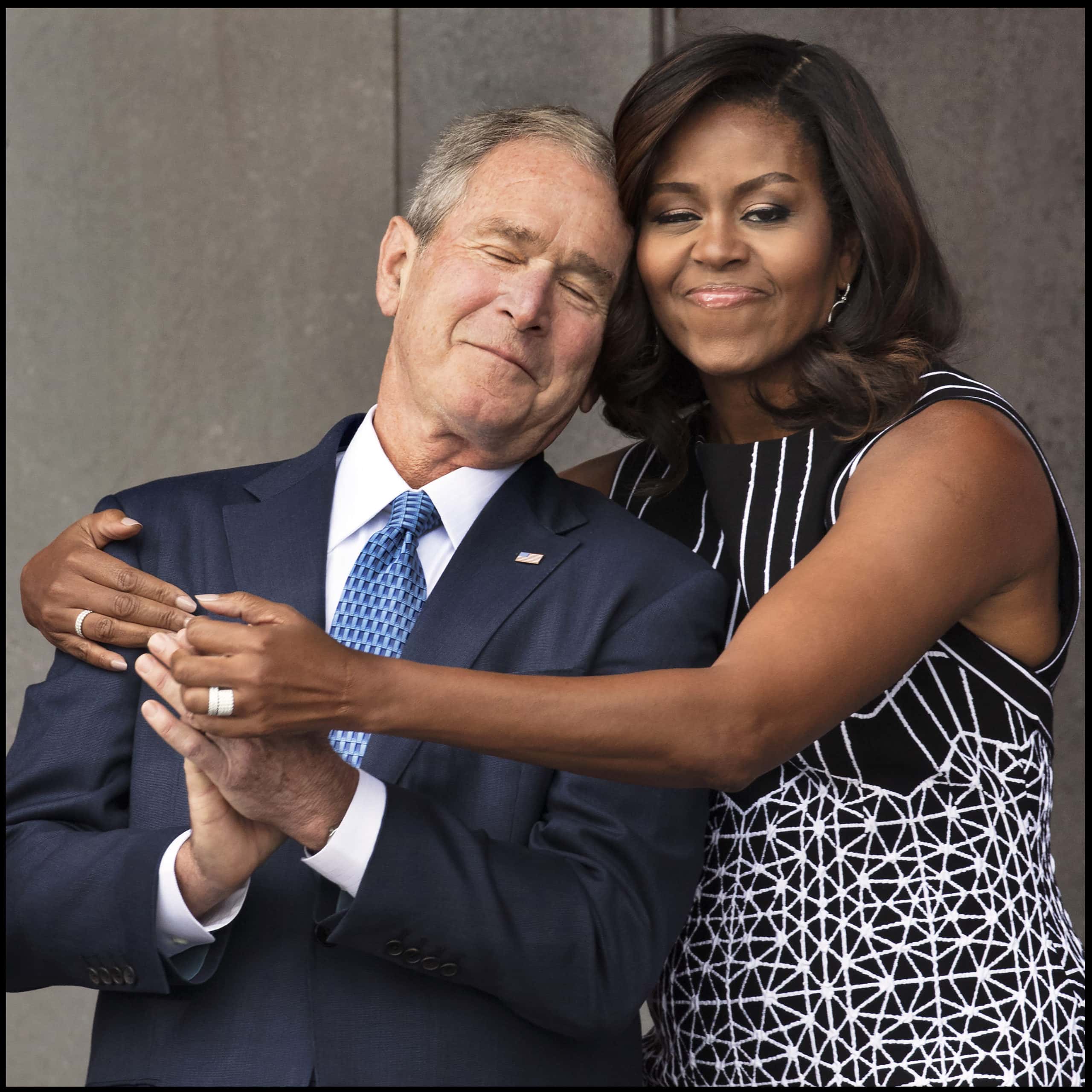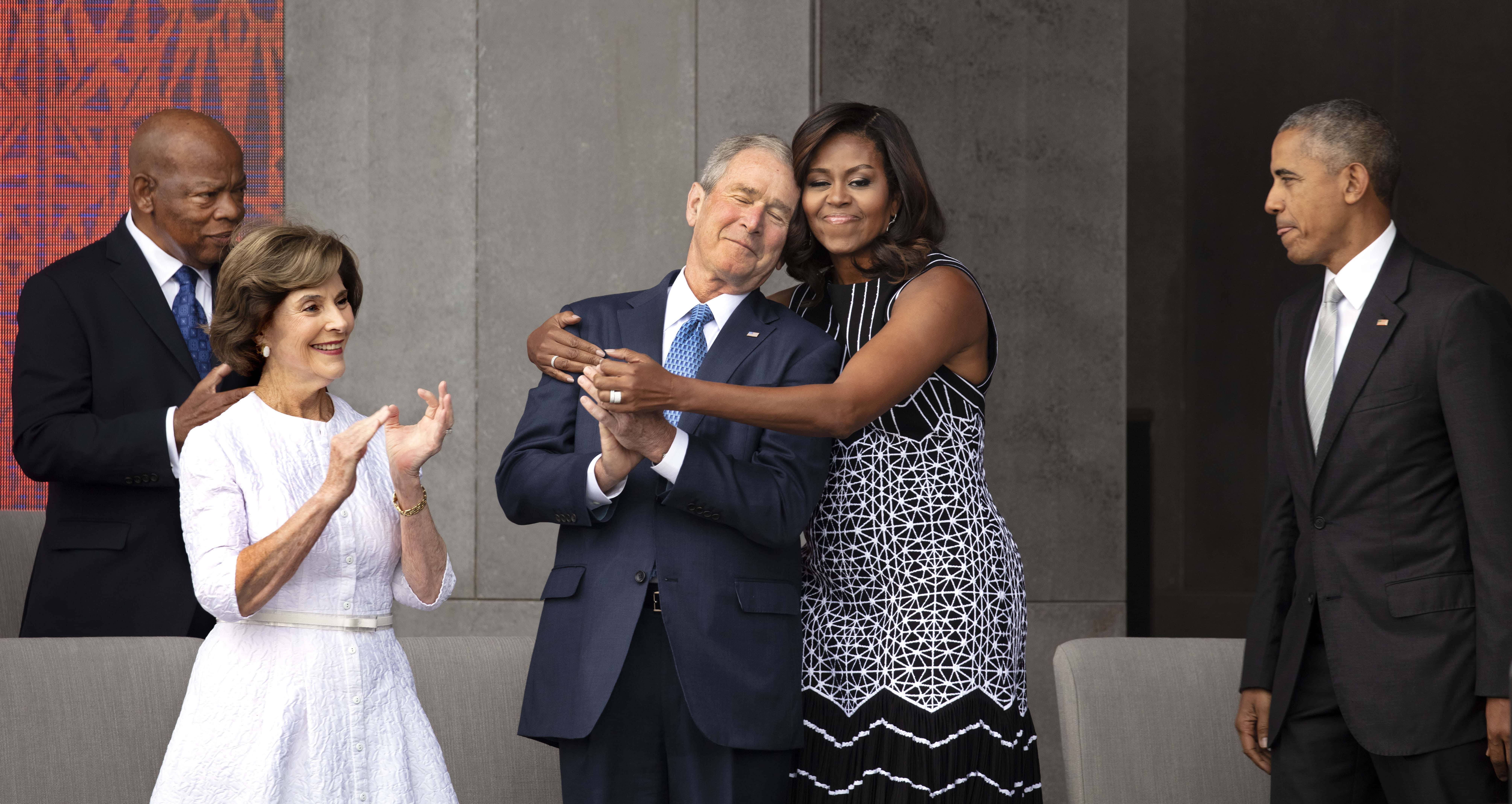This is the first time I've unveiled my uncropped "The Hug" photo from the dedication of the National Museum of African American History and Culture (NMAAHC) in 2016. This version honors the late Rep. John Lewis who died July 17th. Along with First Lady Michelle Obama and former President George W. Bush, former First Lady Laura Bush and President Barack Obama are also in the picture.
I took this photo while on assignment for Bank of America, a major corporate sponsor of the Museum, I immediately knew that the hug was a great moment. A fraction of a second before or after, or standing a foot in either direction would have produced a lesser image. Another key element was Bush having his eyes closed for that magic instant, and helped to make it stand out. The picture went viral as soon as I posted it online, and has become a much-memed image, further attesting to its popularity!
But there was more to the photo than the version that I put out at the time. Way more.
Cropping is part of my world. You take a little off here, a little off there, the idea is to cut away everything that doesn’t focus on the heart of the story without changing its context. In the case of this photograph I zeroed in on the emotional core of the image, one that showed two people whose mutual affection was both symbolic and heartfelt. There was a black woman hugging a white man. A Democrat hugging a Republican. The kind of moment we would like to see naturally occurring every day, particularly these days.

The reason for the embrace was clear to me. Mrs. Obama was expressing gratitude for the role President Bush played in the formation of the African American museum. In 2003 he signed legislation creating the NMAAHC as part of the Smithsonian Institution, ensuring its home on the National Mall. Rep. Lewis was a key sponsor of the bill, and had been pushing for it since 1988, early in his 30-year Congressional career. Mr. Lewis stood right behind President Bush in the oval office when he made it law. The Congressman said afterward, “Today in America we've moved closer, much closer, to a truly interracial democracy, closer to what Martin Luther King Jr. called the beloved community.''
This image made at the dedication is the non-political and bi-partisan manifestation of those words. But when you clip and trim a photograph, you also excise information. Usually it’s not relevant, but in some cases, like in this instance, what ended up on the cutting room floor was loaded with significant data. The President of the United States, a former first lady, and a great Congressman disappeared from the photo. I can only say that if I had to do it over again, I would have done it the same way, but now the picture is complete.
Knowing John Lewis as I did, he would have forgiven me for cropping him out. The important thing for him was that the museum came into being, and that it was a vital and necessary achievement. He wasn’t one to take credit, but he deserves much of it. Lewis was a monumental figure in his own right. Mr. Lewis will be dearly missed by all of us who care about integrity, strength, perseverance, and character in our public figures.
What John Lewis said at the opening of the NMAAHC was deeply moving to me. Here are his words:
“As long as there is a United States of America, now there will be a National Museum of African American History and Culture. This was a great achievement. I tell you,
I feel like singing the song, the Mahalia Jackson song, from the March on Washington over 50 years ago: ‘How we got over; how we got over.’ There were some who said it couldn’t happen, who said, ‘you can’t do it.’ But we did it. We did it. We are gathered here today to dedicate a building, but this place is more than a building. It is a dream come true.
You and I. Each and every one of us were caught up in a seed of light. We were a vision born in the minds of black Civil War veterans and their supporters. They met right here in Washington, D.C., in 1916., exactly 100 years ago at the Nineteenth Street Baptist Church, still in existence today. Oh say, oh say: See what a dream can do. Roll up the sleeves of those veterans or touch the rubble on their backs — you might find the wounds of shackles and whips. Most could not read the Declaration of Independence or write their own names. But in their hearts — burning, enduring vision of true democracy that no threat or death could ever erase.
They understood the meaning of their contribution. They set a possibility in motion, passing down through the ages from heart to heart and breath to breath. That we are giving birth today to this museum is a testament to the dignity of the dispossessed in every corner of the globe who yearn for freedom. It is a song to the scholars and scribes; scientists and teachers; to the revolutionaries, and the voices of protest; to the ministers in the office of peace. It is a story of life, the story of our lives, wrapped up in a beautiful golden crown of grace.
I can hear the distant voice of ancestors whispering by the night fire: ‘Steal away, steal away home, ain’t got long to stay here.’ A big bold choir shouting, ‘I woke up this morning with my mind stayed on freedom.’ All of the voices roaming, for centuries, have finally found a home here in this great monument to our pain, our suffering, and our victory.
When I was a little child growing up in rural Alabama, a short walk to the cotton fields, but hundreds of miles from Washington, from the Washington Monument or the Lincoln Memorial, my teachers would tell us to cut out of pictures of great African Americans for Carter G. Woodson’s Negro History Week, now called African American History Month. I became inspired by the stories of George Washington Carver, Jackie Robinson, Rosa Parks, and so many others whose life and work would be enshrined in this museum.
As these doors open, it is my hope that each and every person who visits this beautiful museum will walk away deeply inspired, filled with a greater respect for the dignity and the worth of every human being and a stronger commitment to the ideals of justice, equality and true democracy.
Thank you.”
Congressman John Lewis
September 24, 2016
Washington, D.C.
Photo by David Hume Kennerly
Canon 5Dsr, 100-400mm lens @400mm
Center for Creative Photography, The University of Arizona: David Hume Kennerly Archive.
© Center for Creative Photography, Arizona Board of Regents

Leave a Reply
You must be logged in to post a comment.